Roman Sites

In addition to the Roman Sites pages (listed below), the individual Beyond Village pages include a brief Roman history and list important artifacts and ruins, when known.
Alaunium
This was the large roman settlement of Alaunium, at the crossroads of the Roman Domitienne Way and another Roman road. It was the most important stop on the Via Domitia between Apta Julia (Apt) and Segustero (Sisteron).
Pont Ambroix
The one remaining arch of an 11-arch Roman bridge on the Via Domitia, beside Ambrussum, southwest of Nîmes.
Ambrussum
Pre-Roman oppidum and Roman archeological site that was a stage stop on the Via Domitia.
Arles Amphitheatre
Complete Roman arena (or Amphitheatre) in the center of Arles, used in the 1st-4th centuries for charriot races and gladiators; today for bull fights, plays and concerts.
Arles Theatre Antique
The Roman Theatre is in the heart of Arles (close to the Arena), built in the 1st century to entertain 15,000 spectators.
Barbegal Mill, Aqueduct
Roman water-powered flour mill complex fed two aqueducts taking drinking water to Arles, "the greatest known concentration of mechanical power in the ancient world".
Cesars Camp Laudun
A small Roman hilltop town, on a site inhabited continually from around 600 BC to the 5th century AD.
Roman Domitienne Way
This Roman's Domitienne Way "Voie Domitienne" was built during the rule of the Roman emperor Titus Flavius Domitianus (51-96). Vestiges of the Domitienne Way can be seen in several Provence towns, from Montgenèvre and Briançon in the Alpes to Narbonne and Perpignan heading into the Pyrenées.
Glanum
A pair of Roman monuments and an excavated Roman town on a site dating from the 4th century BC. A "must see"; plan at least an hour's stop here.
Pierre-Ecrite
Large Roman inscription (the written stone) between Sisteron and Saint Geniez.
Les Plaines Roman Bridge
A small twin-arched stone Roman bridge on the plains of the Var departement, crossing a small stream that divides a land of solid rock and wide, green vineyards.
Pont du Gard
The Pont du Gard is a three-level stone aqueduct crossing the Gardon river valley, about 25 km west of Avignon. Built over 2000 years ago, in 19 BC, by Marcus Vipsanius Agrippa, the son-in-law of Augustus.
Pont Julien
A lovely three-arched, stone Roman bridge crossing a small stream west of the town of Apt.
Roman Millstones St-Quentin-la-Potèrie
This 2000-year-old quarry, a short hike from St Quentin-la-Potèrie, was used by the Romans and up to the19th century as a source of grinding wheels for flour mills in area around Uzès. Today, the woods have been cleared of an area of about 100 meters of rockface, revealing the area exploited at the end of the Roman Era (4th - 6th centuries).
Trophée des Alpes
This Roman monument site on the road into Gaul was a 50 m high monument to the power of Rome and the glory of Augustus. Now only 35 m high and half in ruin, it's still an imposing monument, over 2000 years after it was built.
Vaison-la-Romaine Puymin
The Roman Ruins at Vaison-la-Romaine are some of the biggest in France. The two main sites that can be visited (Puymin and La Villasse) are located in the center of town, near the Office de Tourisme.
Vernegues Roman Temple
1st-c BC Roman Temple with a tall Corinthian column and adjoining 12th-c chapel, in a lovely woods setting
Villa Marius
This is the site of the largest Gallo-Roman farm and winery in Provence, located near Roquebrussanne in the Var.


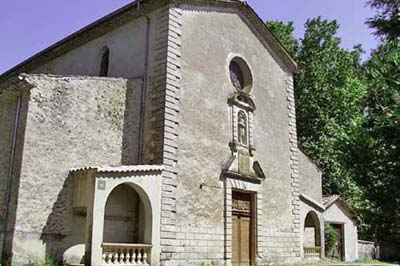
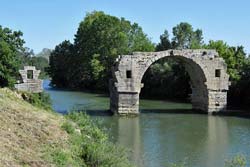
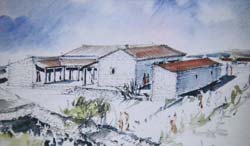



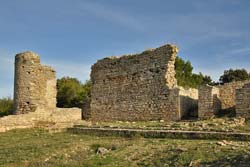
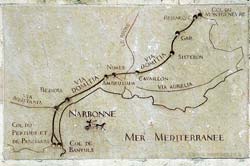



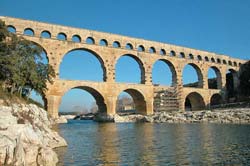

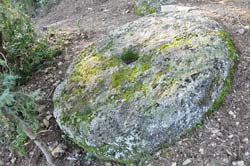
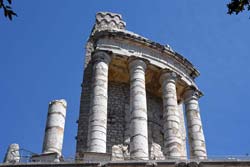


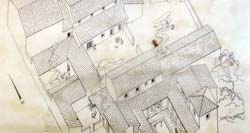
 After 25 years online, I've decided to remove all Ads from my one-man web Provence Beyond. If the content is enjoyable or useful to you, I would really appreciate your support.
After 25 years online, I've decided to remove all Ads from my one-man web Provence Beyond. If the content is enjoyable or useful to you, I would really appreciate your support.